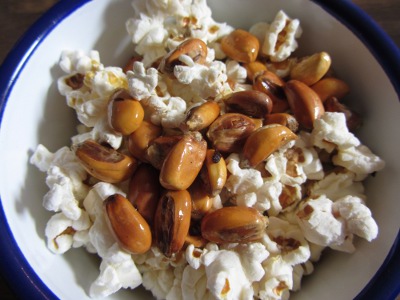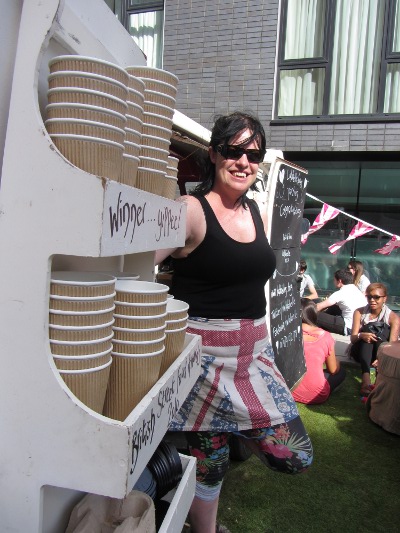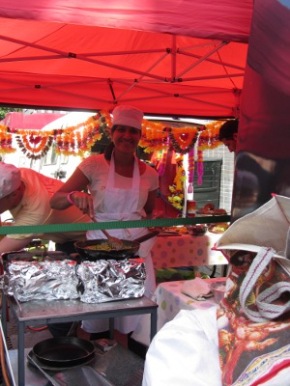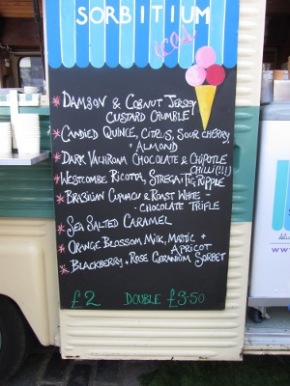Living as a child in countries including Singapore and Italy made me understand the power of food to connect one to a place, especially when one is an ex-patriate. It was my personal nostalgia, the desire to cook with ingredients such as lemongrass or fresh ricotta, which inspired my first ever book, Food Lovers’ London. Researching the first edition of the book – in those long ago, pre-Internet days – gave me an insight into the multi-cultural richness of London’s food scene and how important food was for communities living here as a source of identity – and comfort. I was, therefore, very pleased to be approached by the ProEcuador team and invited by them to learn more about Ecuadorean food –a cuisine of which, as I explained candidly, I knew nothing at all.
The first port of call on my Ecuador in London journey was Chatica, a lively café, bakery and food shop, tucked away near the Elephant and Castle shopping centre. Stepping inside the door I am assailed by the sound of people talking, Latin American music playing in background, the clatter of cups and plates, and a lovely scent of baking. “That’s my land,” says Juan Carlos Yepez Franco of the ProEcuador team, appreciatively; “it smells like home.” As I sit and talk over breakfast with Juan Carlos and Ecuadorean chef David Reyes Prieto it becomes apparent that while many ingredients are shared, the differences between national cuisines in Latin America are at once nuanced and important.
While the café is predominantly Colombian, it offers Ecuadorean dishes, among them humitas, a type of dumpling made from sweetcorn. “We steam them, but in Brazil they boil them” David tells me. The sweetcorn for the humitas “mustn’t be too young or too ripe, it has to be in the middle.” The corn kernels are “put in a mill and you grind it, grind it – it’s a wet paste.” The paste is seasoned, filled with cheese, garlic and annatto, then wrapped in the corn husks to make a parcel. “There’s a special way to fold it– it’s quite tricky, though it looks simple. We eat them with coffee and a chilli sauce – every household makes one – spring onions, chilli, onion and tomato, finely chopped or blitzed” We breakfast companionably on freshly baked pan de yuca – light-textured, mild in flavour – and humitas, which remind me of a moist cornbread, both definitely comfort foods that one would pine for. “Once you start eating them, you can’t stop,” says Juan Carlos happily
David talks me through important Ecuadorean ingredients both in the deli section of the Chatica and also in the nearby Chatica food shop, impeccably neat, with gaudy pinatas hanging from the ceiling. Annatto – either seeds or a puree – is an important ingredient – “it gives colour and makes the dish taste different.” Annatto is often used in the alino, a flavouring which can be made from onion, garlic, annatto, cumin seeds and coriander stalks. “Every grandmother or mum would have this in her fridge and when she fries a piece of meat or makes a soup she uses it for flavour. Everyone has their own version. My mum’s is different from my grandmother’s.” Grains, pulses and starchy vegetables, such as yucca or plantain are fundamental in Ecuadorean cuisine. Corn is widely used, “for us corn is the big white one, not the small yellow one.” Among the unfamiliar ingredients, I recognise one familiar one – a homely packet of Quaker Oats, used David tells me to make a drink, usually with pineapple. “It reminds me of home,” he says, “since I was little I know that brand.” “Me, too,” I tell him.
Ecuadorian cuisine I realise is characteristically frugal, with nothing wasted. “My grandmother never uses stock cubes. She would make oxtail soup or chicken soup with the legs, the feet, the heads, we use everything.” When it comes to protein, David tells me that it is “important for an Ecuadorean to have a piece of meat or chicken or fish in a meal. When you go to the market you ask for one kilo of meat with bones or one kilo without bones. That’s it. Two options.” He was surprised at all the cuts of steak he found when he came to England. “Fillet steak, sirloin – I had never seen them before.”
Both the Chatica café and food shop are owned by Cesar Balbuena, a Colombian who runs a successful business importing foods from South America. “When we started it 15 years ago, nobody was bringing them in, so we saw the opportunity. It was hard work and we made mistakes. I brought in one tonne of yellow potatoes by air and that was too expensive. That was the first mistake; we made others,” he laughs. Where once there were only a handful of three or four South American shops, he now supplies 500 customers. The Chatica shop at Newington Butts is widely known within the Latin American community; an important resource for people looking to cook the dishes of their homelands. “As I was importing the ingredients, I thought well, why not open a café and use our products? That’s how Chatica started. It’s a bit of mixture – mostly Colombian, because we are Colombians, but also Ecuadorean and Peruvian and we’re looking for a Bolivian chef. Every country has their own way. People miss their food and they come here and they find a little taste of their country.”
Following my visit to the café and food shops, I meet up with Juan Carlos and Priscila Nava of the ProEcuador team for an Ecuadorean lunch. Hidden down a narrow Soho side street, right in the heart of London, is Tostado, a recently opened Ecuadorean restaurant, an intimate place, with an appealingly rustic décor, with tiled floor, a wooden bar and whitewashed walls. This is my chance to try ceviche, prepared the Ecuadorean way. While Peruvian ceviche classically uses the acidity of lime juice to ‘cook’ the fish. “we don’t do this,” David had told me. “We cook the prawns or fish or chicken and then we use a marinade of tomato, lime and orange, and use some of the water from the cooking too.” It is a dish associated with the beach, where you find people making it. “It’s irresistible,” chimes in Juan Carlos, “to have a little ceviche at the beach. It’s a must!”
Sitting in Tostado, we have a long and pleasurable discussion on ceviche. Usually, ceviche is served cold, but there are warm versions, Juan Carlos tells me. “I remember my mum doing one where the prawns are freshly cooked and she mixed everything together and served it at once.” In Ecuador, ceviche is often served with maiz tostado (roasted corn) after which the restaurant is named. “You often have ceviche with popcorn which is very, very popular. The popcorn goes on top and soaks up the juices.” He gestures and I notice the popcorn machine in the corner. . Whereas in Peru, fish ceviche is more popular, in Ecuador, says Juan Carlos emphatically, “prawn ceviche is the one. We have the best prawns in the world. The prawns have to be fresh. In Ecuador people know whether a ceviche has just been made or has spent three or four hours in a fridge.”
The Ecuadorean prawn ceviche when it arrives lives up to the pride with which it has been talked about. It is at once subtle yet flavourful. The juicy prawns, flavoured with tomato, orange juice and red onion, are very good indeed, as is the light, fresh-tasting juice – which for Juan Carlos, “is the best part.” It arrives with both popcorn and toasted corn, which has a delicious nuttiness to it, irresistibly more-ish.
Acknowledging the rich Spanish heritage which is part of Ecuador’s culture, we also enjoy a special Easter dish called fanesca, traditionally only eaten during Holy Week. Around 80% of Ecaudor’s population is Catholic and the custom of fasting days has influenced the cuisine, which contains many fish dishes. It is a special dish, rich with symbolism, which although from Quito is very much a national dish, eaten even on the coast. Appropriately to a cuisine so rich in grains and pulses, fanesca contains twelve grains, which represent the Apostles and salt cod, soaked for several hours before cooking. Juan Carlos has vivid memories of his grandmother making the dish on a grand scale to feed her large family at Easter. “It was a labour of love. She wasn’t making it for herself, she was cooking it for her sons, her daughters, her grandchildren. All the grains needed to be soaked. I remember seeing all these bowls with grains in it soaking for days.” The fanesca at Tostado is subtle yet rich – a comforting dish with a delicious nuttiness to it from the assorted grains and salty savouriness from the salt cod.
Like other Ecuadoreans in London, Juan Carlos is delighted that Tostado has opened, showcasing Ecuadorean food in the heart of the city’s West End. “I’ve been here several times. I think it’s the best place for Ecuadorean food. When it opened, even the Ambassador came to the opening,” he tells me. I think back to my conversation with Cesar. I’d asked him whether he thought people in London were becoming more aware of South American food. “Now they know about Peruvian food. The rest of the countries not much, but Peruvian food yes!” We have a lot more interesting food exploring to do. Pleased to have learnt something of Ecuadorean food – and very happy indeed to have sampled it and in such convivial company – I step out into Ecuador into a Soho side-street and yet again marvel at London’s capacity to contain many worlds.





















